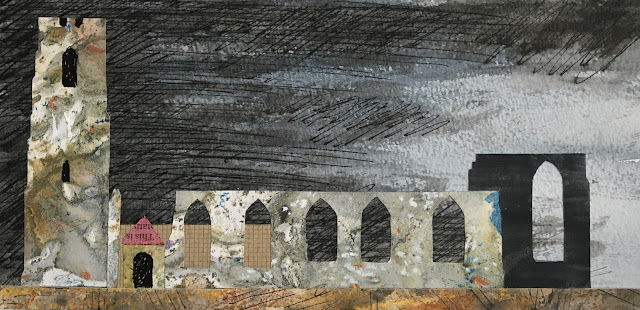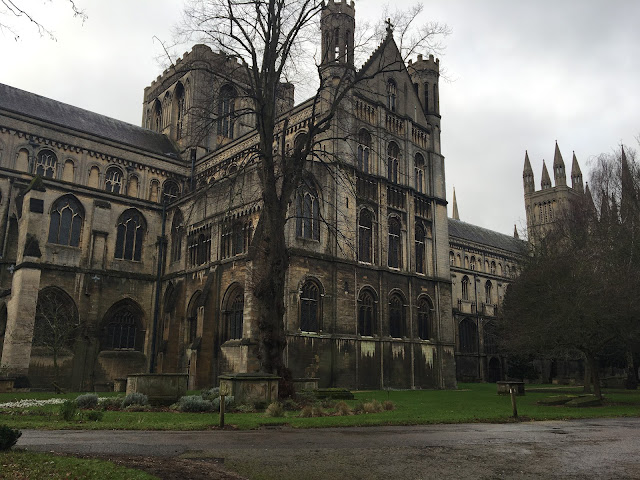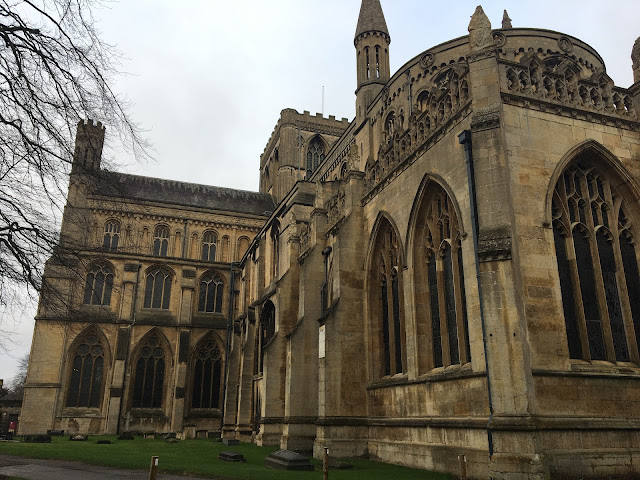My latest collage; 'Covehithe Church' on the coast of Suffolk. A vast church that was partially demolished in the end of the 17th century as surplus to requirements, and a smaller, much smaller church erected within the ruins. A rather M R James sort of place. 22cms x 10.4 cms on watercolour paper.
Thursday, 29 February 2024
Sunday, 25 February 2024
Exhibition
I am pleased to announce my next exhibition will be at Aberglasney Gardens, Carmarthenshire 22.03.24 - 28.03.24. The gardens are open 10am-5pm everyday. Do pop along if you can!
'The Jewel in the Crown'
'....the
spectacle of two nations in violent opposition, not for the first time nor
as yet for the last because they were then still locked in an imperial embrace
of such long standing and subtlety it was no longer possible for them to know
whether they hated or loved one another, or what it was that held them together
and seemed to have confused the image of their separate destinies....'
In
1977 Barbara Pym, after years of critical neglect, was shortlisted for the
Booker prize for her late novel 'Quartet in Autumn'. The prize however
was in the end awarded to Paul Scott for 'Staying on', a novel set in
post-independence India. Being a Pym fan I've often regretted that she
lost that November evening in 1977, as she never seemed quite to have received
the acclaim due to her in her own lifetime.1
However reading 'Jewel in the Crown' - the first novel of
the 'Raj Quartet' - I have modified my opinion. Scott was obviously a
profoundly talented writer, well deserving of such public recognition, which
seems particularly poignant when one considers that he was too ill to attend
the award ceremony - cancer and alcoholism. He died the following March.
'This is the story of a rape, of the events that led up to it and
followed it, and of the place in which it happened.'
'The Jewel in the Crown' is set in those turbulent years at the end of
the British Raj. In particular it focuses on the events in the fictional north
Indian city of Mayapore in the midst of World War II when in the wake of the
Viceroy's declaration of war against the Axis Powers and the successful
Japanese assault on Burma the Indian National Congress mounted the 'Quit India
Campaign'. In the resultant violence two English women resident in
Mayapore are assaulted, one sexually. And it is this period in the
history of India that Scott experienced first-hand as an officer in the British
Army in the subcontinent and Burma.
'The Jewel in the Crown', which has no single linear narrative as
such, pieces together from various witnesses the story of these two
women. There are letters, diary entries and records of conversations; the
result is more like a dossier. However, the compiler of this dossier,
whether journalist or academic, remains unknown, though we can surmise that
this research is undertaken some years after independence. The result is utterly
compelling, a dazzling piece of literature.
Mayapore consists of two areas; the original city and the
cantonment which housed the British military and civilians. I think I
should add here that these cantonments were constructed all over sub-continent
in the wake of the Indian Mutiny/Rebellion of 1857. In the case of
Mayapore this segregation of communities is further enforced by the presence of
a river and a railway line between them. The characters and therefore the
plot, however, inhabit a third, intermediate, space between those two sometimes
harsh realities. I do not mean these characters are necessarily
outsiders; Lady Chatterjee for instance is certainly no outsider, being very
well connected socially in both communities; but others such as the perceptive
Sister Ludmilla, who is rather like an Orthodox yurodivy (a fool-in-Christ),
most certainly are. She is rather like a piece of driftwood that the
tides of life and fate have left stranded in the city.
It is through her eyes that we first encounter Hari Kumar, oddly
Nehru-like2 and adrift between cultures, and Ronald Merrick,
the local police superintendent, on what is their first meeting; and through
her observations of that inauspicious event, we learn that Merrick is
homosexual:
'It was so with the policeman. The policeman saw him too. I
always suspected the policeman. Blond, also good looking, he also had
sinews [like Kumar], his arms were red and covered with fine
blond hairs; and his eyes were blue, the pale blue of a child's doll; he looked
right but didn't smell right. To me, who had been about in the world, he
smelt all wrong. "And who is that?" he said. "Also
one of your helpers? The boy there? The boy washing at the
pump?"
I would argue that from this passage (with its sly,
'under-the-radar' homo-eroticism) in which sister Ludmilla stresses the
similarities between the two men, and from what is said later in the novel, that
Kumar too is homosexual. As I was working on this post, and in particular on this scene, I began to wonder about Scott's own sexuality; it turns out that
although he was married (unsuccessfully) he was himself homosexual. I
cannot help but feel that somehow that knowledge, for me at least, changes the
dynamic of the relationship between Kumar and Merrick, and between the characters
and the author. Perhaps not in a comfortable way.
Both men, however, regardless, or because of their sexuality,
attempt to pursue a relationship with clumsy, awkward Daphne Manners, and it is
this fierce little tragedy played out against the vast flow of history that
forms the core this novel.
There is something of the French and Russian nineteenth century
novel about 'The Jewel in the Crown' in its scope. A vast, sprawling sort
of book echoing a vast and complex setting. In a sense it is an attempt
(perhaps in the manner of Dostoevsky) to understand, or even define India,
which is as much a creation of the British administration and British and
European political thought as much as anything else. It is a hybrid
polity. This attempt to reach such a definition (if such a thing is possible)
is something that also occupied the mind of another British writer of the 20th
century, E M Forster in 'A Passage to India' - it must be either audacity or
hubris that made Forster think he reduce India to 'God si Love', but then he
was one for the apophthegm. One gets a sense, particularly towards the end of
the novel, not only that 'India' is something that the British could not, or
would not, understand but that the leaders of the independence movement were
little different. But then the struggle for Independence was at some
level a conflict of elites. India was, like Post-War Britain to be a seed-bed
for elite-driven utopian planning. For Nehru, schooled in late nineteenth
century British socialism of the Fabian variety, India was to be transformed into
the image of the nation whose rule he rejected. Indeed, the whole process
of independence was fraught with paradox. That isn't meant as a
criticism. We all exist in some sort of paradox; it's all part of the
human condition.
1 There is
a marvellous, gently melancholic drama of that day, 'Miss Pym's Day Out',
written by James Runcie for the BBC series 'Bookmark', and starring Patricia
Routledge. It's quite easy to find on YouTube.
Friday, 16 February 2024
'Bluebeard's Castle'
The film virtually disappeared after broadcast until last year (2023) when, after restoration, it was released as a DVD by the BFI. The result if an absolute real visual treat. The sets are spectacular but ethereal, the work of the designer Hein Heckroth who had worked with Powell and Emeric Pressburger on 'The Red Shoes', 1948, and 'Tales of Hoffman', 1951.
Bluebeard's Castle
1963
Cinematogrpahy Hannes Staudinger
Producer Norman Foster
Tuesday, 13 February 2024
Peterborough Cathedral II: The Minster Precinct
It shouldn't be a surprise, then, that the Precinct is a favourite of mine. There is something so eminently civilised about the place, and it is still after all those intervening years a real pleasure to walk through, even though it appears that many of the houses are now rented out as offices and there are too many cars parked about. But a refuge still from the surrounding city.
Friday, 9 February 2024
Peterborough Cathedral I: The Exterior
On the Friday I left London for a few hours and took a trip north by train to Peterborough, to continue a project to visit all the Anglican cathedrals within easy reach of London - one visit per stay in London. Oddly, considering I lived near Peterborough for many years, the cathedral has never yet been a subject for a blogpost, but by the time I started this blog I had grown to dislike the city. It had by then become merely a place to change buses or catch a train. There were other places, pleasanter places, to do shopping. Like far too many cities in the UK Peterborough has suffered greatly in the 20th century from rapacious Modernity. I'd go so far to say that by & large our market towns are very good, but our cities are poor.
That first foundation was destroyed during the Viking Raids, when Abbot Headda and the community were martyred. The second foundation*, Benedictine, continued until dissolved in 1539. In 1541 it was reconstituted as a Cathedral - part of Henry VIII's attempts to re-structure the church. In the intervening two years it apparently functioned a collegiate church. The diocese, which was carved out of the vast diocese of Lincoln, consists of the Soke of Peterborough and the county of Northamptonshire. In the upheavals of the 17th century the cathedral suffered mightily, though perhaps not as badly as Lichfield. The cathedral underwent two major restorations in the 19th century, firstly, by Blore and then Pearson. Leslie Moore, son of Temple Moore, and then George Pace worked here mid-century, but latter didn't do too much damage. Thankfully.
And so mercifully to the architecture. Perhaps, because it's so familiar to me, Peterborough always strikes me as a work-a-day sort of building; apart from the w end it has a straightforward masculine quality to it, with none of the complexity of, say, Lincoln. Perhaps also because it is essentially a Norman building, robust and powerful, even a little remorseless at times in its logic. And - dare I say it? - monotonous. The scale is large - 471 ft long and 180 across the transept. You certainly have to admire the ambition and the audacity of the original masons, and the abbot who commissioned them. Apart from the extraordinary Early English w front, which seems to define any logic, there are few further additions to the structure, which furthers the sense of homogeneity. There are some elegant Geometric Decorated Tracery in the s transept chapels; more importantly there is the 14th central tower (rebuilt by Pearson), and New Building. This was the last addition to the structure, built as an ambulatory around the e end under the patronage of Abbot Kirkton. The master mason, it is suggested, is likely to have been John Wastell - the new Building has detailing very similar to King's College Chapel, Cambridge where Wastell was master mason from 1508 onwards.
The west front deserves a paragraph to itself. At some 156ft wide, it really is quite something like an immense scaenae frons; unique in the British Isles and, I think, in Europe. I'm not sure architectural historians or critics are that fond of it per se, impressed though they may be by the scale and the concept which verges on the sublime. The design can be best thought of consisting of two layers, one behind the other. The outer layer consists of three immense arches, that apart from the central arch have little relationship to what's going on in the building behind. Pevsner calls them 'niches' which seems an understatement. These arches, in fact, form a sort of loggia. At each end of the façade are big, square turrets (or are they towers?), each capped with later stone spires; they are probably there to act as buttresses. Over the arches are three massive gables; the central one being a continuation of the nave roof. Historians seem quick to look to Lincoln cathedral for inspiration for this design but ignore the remains of the massive w front of the abbey church at Bury St Edmunds (another Benedictine house). The great width of the façade like that at Bury is explained by the presence of a Western transept (there was also one at Ely), but unlike those transepts, the one at Peterborough is a narrow, blink-and-you-miss-it affair, which also attempts to combine the western transept with a two towered façade. Ely has a single central west tower, and Bury, depending on the re-construction, three or five. It is this western transept that forms the inner layer. Its external projection are the two towers peaking over the two outer gables. Unhappily the s tower has never been attempted, as its absence does detract from the overall composition. Finally in the middle - a little oddly for some critics - is a Perpendicular Gothic porch. Ruskin, for one, thought without the porch, the w front would be the finest in Europe.
Apologies for the photography. It was a more overcast day than I had anticipated. I decided not to pack my camera and, instead, use my phone. A mistake.
Thursday, 8 February 2024
'The Reckoning'
After watching this film, you might even suspect that Jack Gold (wrongly, I should think) was a misanthrope. It certainly isn't easy to work out which class he disliked more, the industrial working or the managerial middle.
The Reckoning
1969
Cinematogrpahy -
Producer Ronald Sheldo






























